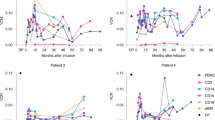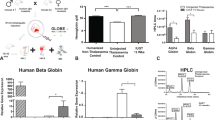Abstract
The stable introduction of a functional β-globin gene in haematopoietic stem cells could be a powerful approach to treat β-thalassaemia1 and sickle-cell disease2. Genetic approaches aiming to increase normal β-globin expression in the progeny of autologous haematopoietic stem cells3 might circumvent the limitations and risks of allogeneic cell transplants4. However, low-level expression, position effects and transcriptional silencing hampered the effectiveness of viral transduction of the human β-globin gene when it was linked to minimal regulatory sequences5. Here we show that the use of recombinant lentiviruses enables efficient transfer and faithful integration of the human β-globin gene together with large segments of its locus control region. In long-term recipients of unselected transduced bone marrow cells, tetramers of two murine α-globin and two human βA-globin molecules account for up to 13% of total haemoglobin in mature red cells of normal mice. In β-thalassaemic heterozygous mice higher percentages are obtained (17% to 24%), which are sufficient to ameliorate anaemia and red cell morphology. Such levels should be of therapeutic benefit in patients with severe defects in haemoglobin production.
This is a preview of subscription content, access via your institution
Access options
Subscribe to this journal
Receive 51 print issues and online access
$199.00 per year
only $3.90 per issue
Buy this article
- Purchase on Springer Link
- Instant access to full article PDF
Prices may be subject to local taxes which are calculated during checkout






Similar content being viewed by others
References
Weatherall, D. J. & Clegg, J. B. The Thalassemia Syndromes (Blackwell Scientific, Oxford, 1981).
Nathan, D. G. & Oski, F. A. Hematology of Infancy and Childhood (WB Saunders, Philedelphia, 1998).
Sadelain, M. Genetic treatment of the haemoglobinopathies: recombinations and new combinations. Br. J. Haematol. 98, 247– 253 (1997).
Boulad, F. et al. Bone marrow transplantation for homozygous beta-thalassemia. Ann. N. Y. Acad. Sci. 850, 498– 502 (1998).
Rivella, S. & Sadelain, M. Genetic treatment of severe hemoglobinopathies: the combat against transgene variegation and transgene silencing. Semin. Hematol. 35, 112–125 (1998).
Tuan, D., Solomon, W., Li, Q. & London, I. M. The “beta-like-globin” gene domain in human erythroid cells. Proc. Natl Acad. Sci. USA 82, 6384–6388 ( 1985).
Forrester, W. C., Takegawa, S., Papayannopoulou, T., Stamatoyannopoulos, G. & Groudine, M. Evidence for a locus activation region: the formation of developmentally stable hypersensitive sites in globin-expressing hybrids. Nucleic Acids Res. 15, 10159–10177 (1987).
Grosveld, F., van Assendelft, G. B., Greaves, D. R. & Kollias, G. Position-independent, high-level expression of the human beta-globin gene in transgenic mice. Cell 51, 975– 985 (1987).
Sadelain, M., Wang, C. H., Antoniou, M., Grosveld, F. & Mulligan, R. C. Generation of a high-titer retroviral vector capable of expressing high levels of the human beta-globin gene. Proc. Natl Acad. Sci. USA 92, 6728– 6732 (1995).
Leboulch, P. et al. Mutagenesis of retroviral vectors transducing human beta-globin gene and beta-globin locus control region derivatives results in stable transmission of an active transcriptional structure. EMBO J. 13, 3065–3076 (1994).
Raftopoulos, H., Ward, M., Leboulch, P. & Bank, A. Long-term transfer and expression of the human beta-globin gene in a mouse transplant model. Blood 90, 3414–3422 (1997).
Grosveld, F. et al. The dynamics of globin gene expression and gene therapy vectors. Semin. Hematol. 35, 105– 111 (1998).
Bulger, M. & Groudine, M. Looping versus linking: toward a model for long-distance gene activation. Genes Dev. 13, 2465–2477 (1999).
Higgs, D. R. Do LCRs open chromatin domains? Cell 95, 299–302 (1998).
Engel, J. D. & Tanimoto, K. Looping, linking, and chromatin activity: new insights into beta-globin locus regulation. Cell 100, 499–502 ( 2000).
Novak, U., Harris, E. A., Forrester, W., Groudine, M. & Gelinas, R. High-level beta-globin expression after retroviral transfer of locus activation region-containing human beta-globin gene derivatives into murine erythroleukemia cells. Proc. Natl Acad. Sci. USA 87, 3386-3390 ( 1990).
Talbot, D. et al. A dominant control region from the human beta-globin locus conferring integration site-independent gene expression. Nature 338, 352—355 (1989).
Bungert, J. et al. Synergistic regulation of human beta-globin gene switching by locus control region elements HS3 and HS4. Genes Dev. 9, 3083–3096 (1995).
Malim, M. H., Hauber, J., Le, S. Y., Maizel, J. V. & Cullen, B. R. The HIV-1 rev trans-activator acts through a structured target sequence to activate nuclear export of unspliced viral mRNA. Nature 338, 254–257 ( 1989).
Porcu, S. et al. The human beta globin locus introduced by YAC transfer exhibits a specific and reproducible pattern of developmental regulation in transgenic mice. Blood 90, 4602–4609 (1997).
Yang, B. et al. A mouse model for beta 0-thalassemia. Proc. Natl Acad. Sci. USA 92, 11608–11612 (1995).
Fabry, M. E. et al. A second generation transgenic mouse model expressing both hemoglobin S (HbS) and HbS-Antilles results in increased phenotypic severity. Blood 86, 2419–2428 (1995).
Esan, G. J., Adesina, T. A. & Luzzatto, L. Synthesis of haemoglobins specified by allelic genes in human heterozygotes. Nature 229, 143– 145 (1971).
Stamatoyannopoulos, G., Nienhuis, A. W., Majerus, P. & Varmus, H. The Molecular Basis Of Blood Diseases (WB Saunders, Philedelphia, 1994).
Miyoshi, H., Smith, K. A., Mosier, D. E., Verma, I. M. & Torbett, B. E. Transduction of human CD34+ cells that mediate long-term engraftment of NOD/SCID mice by HIV vectors. Science 283, 682–686 ( 1999).
Amado, R. G. & Chen, I. S. Lentiviral vectors—the promise of gene therapy within reach? Science 285, 674–676 (1999).
Zufferey, R., Nagy, D., Mandel, R. J., Naldini, L. & Trono, D. Multiply attenuated lentiviral vector achieves efficient gene delivery in vivo. Nature Biotechnol. 15, 871–875 (1997).
Dull, T. et al. A third-generation lentivirus vector with a conditional packaging system. J. Virol. 72, 8463– 8471 (1998).
Gallardo, H. F., Tan, C., Ory, D. & Sadelain, M. Recombinant retroviruses pseudotyped with the vesicular stomatitis virus G glycoprotein mediate both stable gene transfer and pseudotransduction in human peripheral blood lymphocytes. Blood 90, 952–957 (1997).
Rivella, S., Callegari, J. A., May, C, Tan, C. & Sadelain, M. The cHS4 insulator increases the probability of retroviral expression at random chromosomal integration sites. J. Virol. 74, 4679–4687 (2000)
Acknowledgements
We thank M. Trudel for helpful discussion; C. Tan and H. Beauchemin for technical assistance and I. Rivière for reviewing the manuscript. This work was supported by grants from the NHLBI, the NCI, the Cancer Research Institute, the Cooley's Anaemia Foundation, DeWitt-Wallace Fund and the McDonnell Foundation Scholars Award.
Author information
Authors and Affiliations
Corresponding author
Supplementary information
Rights and permissions
About this article
Cite this article
May, C., Rivella, S., Callegari, J. et al. Therapeutic haemoglobin synthesis in β-thalassaemic mice expressing lentivirus-encoded human β-globin. Nature 406, 82–86 (2000). https://doi.org/10.1038/35017565
Received:
Accepted:
Issue Date:
DOI: https://doi.org/10.1038/35017565
This article is cited by
-
Genome-based therapeutic interventions for β-type hemoglobinopathies
Human Genomics (2021)
-
CRISPR/Cas9-modified hematopoietic stem cells—present and future perspectives for stem cell transplantation
Bone Marrow Transplantation (2019)
-
Development of a forward-oriented therapeutic lentiviral vector for hemoglobin disorders
Nature Communications (2019)
-
Development and characterization of cellular biosensors for HTS of erythroid differentiation inducers targeting the transcriptional activity of γ-globin and β-globin gene promoters
Analytical and Bioanalytical Chemistry (2019)
-
In Utero Gene Therapy (IUGT) Using GLOBE Lentiviral Vector Phenotypically Corrects the Heterozygous Humanised Mouse Model and Its Progress Can Be Monitored Using MRI Techniques
Scientific Reports (2019)
Comments
By submitting a comment you agree to abide by our Terms and Community Guidelines. If you find something abusive or that does not comply with our terms or guidelines please flag it as inappropriate.



